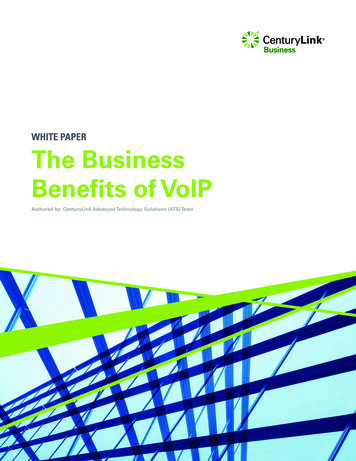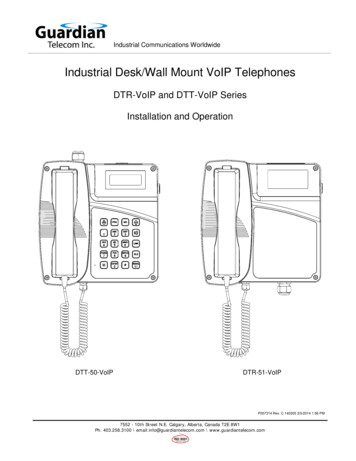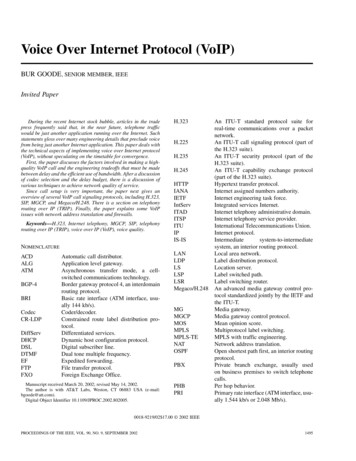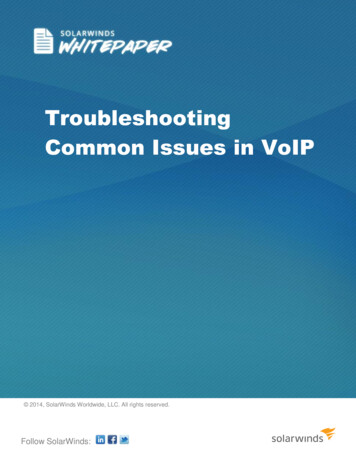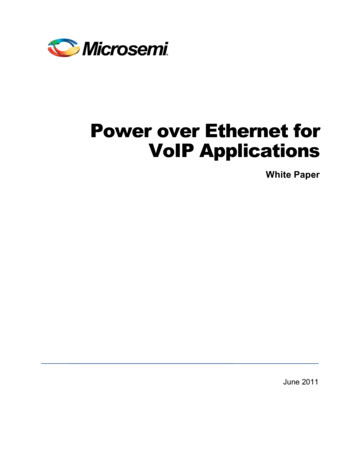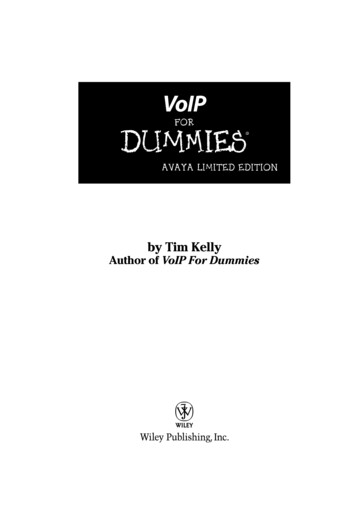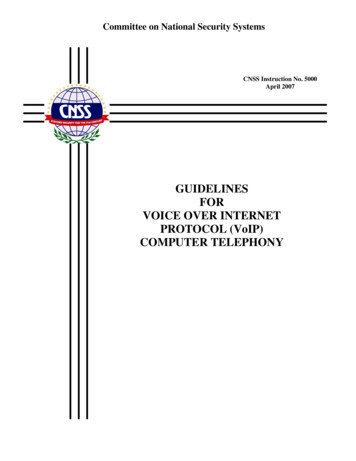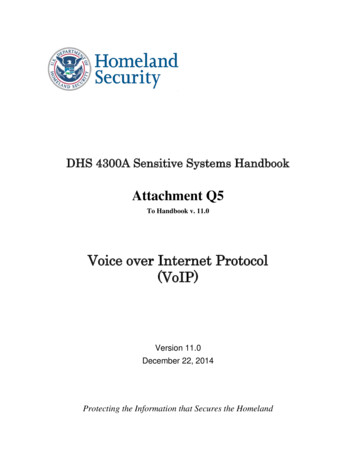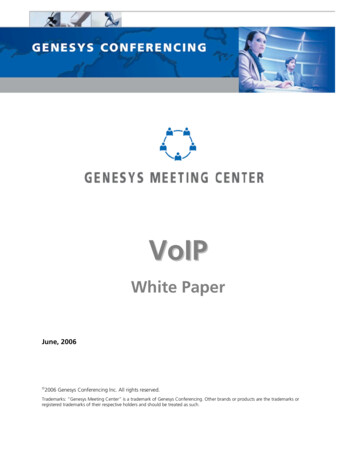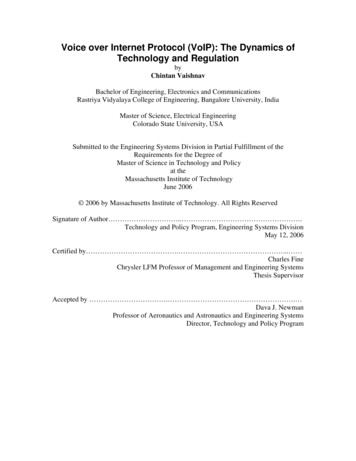
Transcription
Voice over Internet Protocol (VoIP): The Dynamics ofTechnology and RegulationbyChintan VaishnavBachelor of Engineering, Electronics and CommunicationsRastriya Vidyalaya College of Engineering, Bangalore University, IndiaMaster of Science, Electrical EngineeringColorado State University, USASubmitted to the Engineering Systems Division in Partial Fulfillment of theRequirements for the Degree ofMaster of Science in Technology and Policyat theMassachusetts Institute of TechnologyJune 2006 2006 by Massachusetts Institute of Technology. All Rights ReservedSignature of Author . .Technology and Policy Program, Engineering Systems DivisionMay 12, 2006Certified by . . Charles FineChrysler LFM Professor of Management and Engineering SystemsThesis SupervisorAccepted by . . Dava J. NewmanProfessor of Aeronautics and Astronautics and Engineering SystemsDirector, Technology and Policy Program
2- -
Voice over Internet Protocol (VoIP): The Dynamics ofTechnology and RegulationbyChintan VaishnavSubmitted to the Engineering Systems Division on May 12,2006 in Partial Fulfillment of the Requirements for the Degreeof Master of Science in Technology and PolicyAbstract"What Voice over Internet Protocol (VoIP) is going to do is start to weaken the foundationof the way we've done things for 100 years Congress already should be discussing the nexttelecom bill,” said Federal Communications Commission (FCC) Chairman Michael Powell inFebruary 2004, before the United States Senate. The objective of this thesis is to study howVoIP challenges the incumbent US telecommunications act.The appearance of VoIP comes at a juncture when telecommunications system has alreadyturned into a large-scale, complex system with multiple, competing infrastructures. VoIP,however, greatly augments the nested complexity by affording a technology that enablesmultiple architectures and business models for delivering the same voice (and oftenconverged voice and data) service, while remaining agnostic to the underlying infrastructure.The VoIP-enabled architectures have very different capabilities and costs from one another.Many do not – or cannot – support social regulations such as emergency 911, wiretappingand disability access. Most exploit the economic arbitrage opportunities by evading accesscharges and universal service contributions. Added to this is the combination of reducedasset specificity due to VoIP’s layered architecture and a global standard based ubiquitous IPtechnology that frees the service providers of the need to own the delivery infrastructure,and enables them to offer service from anywhere globally. Such a misalignment – betweenregulatory obligations and technical capabilities – has the potential to incubate large-scalesystemic failures due to lack of coordination between the local optimization focused privatemarkets and the highly compartmentalized public institutions.The case of Communications Assistance for the Law Enforcement Act (CALEA) – alsoknown as the wiretapping act – is taken to study its implications on VoIP. A systemdynamics model is used for the analysis. Four policy lessons emerge through the process of3- -
arriving at the model and the subsequent sensitivity analysis. First, considering peer-to-peer(P2P) VoIP a non-issue for CALEA is exactly what might make it an issue. Second, if P2PVoIP aspires to be a telephony substitute, it will invite the threat of social regulation. Third,arms race between CALEA-compliant and non-compliant technologies may raise the cost ofCALEA compliance. Fourth, prohibiting use of certain encryption techniques may help theLEA to keep their ability to wiretap intact, but it also deprives customers of the privacy theprohibited schemes would have offered, and thereby helps the Internet-crime.Thesis Supervisor: Charles FineTitle: Chrysler LFM Professor of Management and Engineering Systems4- -
To Hetalfor her love, patience and encouragement,without which MIT would not have happened.5- -
AcknowledgementsI would like to thank the following people in helping me produce this thesis. Prof. Charles FineDirk Trossen, Nokia Research and everyone involved with the CommunicationsFutures ProgramSharon Eisner GillettDavid ClarkDavid ReedGabriel WeinbergNatalie KlymCarlos OsorioBetsy MasielloDavid ZipkinTony LimRita AdomSydney Miller and everyone involved with the Technology Policy ProgramA special thanks to Scott Marcus, Bob Pepper and others at the Office of StrategicPlanning, Federal Communications Commission (FCC)6- -
Table of ContentsAbstract . 3Acknowledgements. 6List of Tables . 11INTRODUCTION . 12Tips for reading this thesis. 13TECHNOLOGY AND REGULATION. 14What is VoIP? . 14Call Signaling. 16H.323. 18Media Gateway Control Protocol (MGCP) and Megaco. 37Transport . 42Delay . 43Voice Quality . 44Regulation . 47Statutory Definitions and Jurisdiction . 47911/E911 . 51CALEA . 54Disability Access . 61Universal Service . 69Inter-carrier Compensation . 80VoIP CLASSIFICATION AND THE REGULATORY CHALLENGES. 81Need for VoIP Classification . 81VoIP Classification . 84VoIP in the Backbone . 84Facility-based VoIP . 85VoIP over Broadband . 86P2P VoIP. 87Nature of Technology and Regulatory Challenges. 88911/E911 . 88CALEA . 88Disability Access . 89Universal Service . 90Inter-carrier Compensation . 91Numbering . 92METHODOLOGY: THE SYSTEM DYNAMICS STANDARD METHOD. 94What is “standard method”? . 94Example of the Standard Method . 95Variables List . 95Reference Modes . 96Problem Statement . 97Momentum Policies . 97Causal Loop Diagram or Dynamic Hypotheses. 98Modeling . 99SYSTEM DYNAMICS MODEL FOR CALEA . 1037- -
CALEA Background. 103Six Variables of interest. 103Reference Modes and Rough Dynamic Hypotheses. 105Variable 1: Number of Lawful Intercepts Required . 105Variable 2: Percentage of Voice Traffic that is VoIP . 107Variable 3: Percentage of Voice Communications Subjected to CALEA. 109Variable 4: Percentage of Voice Communications that can be wiretapped. 111Variable 5: Percentage Intercepts that can be decrypted . 113Variable 5: Percentage Intercepts that can be decrypted . 113Variable 6: Cost of CALEA Compliance . 115CALEA CAUSAL LOOPS. 117Simplified Version . 117Complete Version . 118CALEA - STOCK AND FLOW MODEL. 119Model Construction and Assumptions. 119Parameter Values and Ranges. 127MODEL ANALYSIS AND POLICY LESSONS FOR CALEA . 130MODEL BEHAVIOR. 130SENSITIVITY ANALYSIS AND POLICY LESSONS. 136Policy Lesson 1: Considering P2P a non-issue for CALEA is exactly what mightmake it an issue. 138Policy Lesson 2: If P2P aspires to be a telephony substitute, it will invite the threatof social regulation. 140Policy Lesson 3: Arms race between CALEA-compliant and non-complianttechnologies may raise the cost of compliance. 140Policy Lesson 4: Prohibiting use of certain encryption techniques may help the LEAto keep their ability to wiretap intact, but it also deprives customers of the privacythe prohibited schemes would have offered, and thereby helps the Internet-crime.143REFERENCES . 144Appendix A: Abbreviations . 146Appendix B: VoIP Timeline . 149Appendix C: List of all CALEA Variables. 153Appendix D: CALEA Model Equations . 1558- -
List of FiguresFigure 1. End-to-end VoIP. 15Figure 2 H.323 Gateway . 19Figure 3 Direct endpoint call signaling. 22Figure 4 Gatekeeper routed call signaling (Q.931). 23Figure 5 Gatekeeper routed call signaling (Q.931/H.245). 23Figure 6. Basic call setup with gatekeeper. 25Figure 7. Basic call setup with gatekeeper routed call signaling. 26Figure 8 Gatekeeper routed call signaling involving two gatekeepers. . 27Figure 9 SIP session setup with one proxy server. . 30Figure 10. SIP call setup with two proxy servers. . 34Figure 11 Existing Circuit Switched Networks . 38Figure 12 Master/Slave architecture involving call agents, signaling and media gateways. 38Figure 13 Hourglass model of the Internet . 81Figure 14 Core-Edge Movement . 82Figure 15 Example of a reference mode . 97Figure 16 Example of Causal Loops to form Dynamic Hypothesis . 99Figure 17 Example of a modeled causal loop, its equations and the output. 101Figure 18 Reference modes and rough dynamic hypotheses for number of lawfulintercepts required. 105Figure 19 Number of Wiretaps authorized by US Courts between 1968 and 2002 . 106Figure 20 Reference modes and rough dynamic hypotheses for percentage of voice trafficthat is VoIP . 107Figure 21 Reference modes and rough dynamic hypotheses for percentage of voicesubjected to CALEA . 109Figure 22 Reference modes and rough dynamic hypotheses for percentage of voicecommunications that can be wiretapped. . 111Figure 23 Reference modes and rough dynamic hypotheses for percentage intercepts thatcan be decrypted . 113Figure 24 Reference modes and rough dynamic hypotheses for cost of CALEAcompliance . 115Figure 25 CALEA Causal Loops: Simplified Version . 117Figure 26 CALEA Causal Loops: Complete Version. 118Figure 27 CALEA stock-flow model: VoIP Diffusion. 119Figure 28 CALEA stock-flow model: CALEA compliance. 122Figure 29 CALEA stock-flow model: Impact of CALEA on P2P VoIP. 123Figure 30 Complete CALEA stock-flow model . 125Figure 31 Managed VoIP Diffusion . 130Figure 32 P2P Diffusion . 131Figure 33 Minutes of Use . 132Figure 34 CALEA Jurisdiction . 133Figure 35 CALEA Jurisdiction causal trace . 1359- -
Figure 36 CALEA Causal Loops with Policy Insights. 136Figure 37 Sensitivity Analysis: Sensitivity of Managed VoIP Users to varying Sociability. 137Figure 38 Sensitivity Analysis: Sensitivity of CALEA Jurisdiction and Compliance Costto varying P2P and Managed VoIP Diffusion . 139Figure 39 Sensitivity Analysis: Sensitivity of CALEA Deployment and Compliance Costto varying Development and Deployment Rate of Non-CALEA Solutions. 14210- -
List of TablesTable 1. Types of services that can be offered using SIP . 36Table 2. Delay Budget . 44Table 3. VoIP Classification . 84Table 4. Five regulatory issues, current obligations and VoIP challenges . 93Table 5. Six important variables for CALEA . 104Table 6. Parameter Selection for CALEA Model. 12911- -
Chapter 1INTRODUCTIONSince the introduction of the VocalTec’s VocalChat PC-to-PC phone in March of 1995,many articles in the trade press frequently claimed that, in the near future, telephonetraffic would be just another application running over the Internet. Such statements glossover many engineering, regulatory and economic details that preclude voice from beingjust another Internet application. This thesis is an attempt to provide a framework forunderstanding how voice over Internet protocol (VoIP) technology will impact regulatorychoices, without speculating on the nature of the new regulatory regime.On the technical side, Internet Protocol (IP) being agnostic to the physicalmedium provides a way to run VoIP as an application on wired or wireless networks. Thewired network could be a public switched telephone network (PSTN), cable, digitalsubscriber line (DSL) or the Ethernet. The wireless network could be the wirelesscarrier’s network, such as code division multiple access (CDMA), time division multipleaccess (TDMA) or GSM network, or private networks such as WiFi, BlueTooth orWiMAX. There are multiple, different architectures under which a service provider canoffer a VoIP based voice communications service. At one extreme, it is possible to offerVoIP as an application that utilizes any infrastructure that offers the Internet connectivity.The application provider in this case need not own any parts of the infrastructure. On theother, there can be a complete vertical integration of service where the provider owns theinfrastructure and all the components necessary to deliver service. Therefore, the choiceof architecture determines the service provider’s underlying costs, capabilities and12- -
limitations. This necessitates the study of infrastructure ownership when discussingoptions for regulating various scenarios under which VoIP services is delivered tocustomers.On the regulatory side, voice communications service has been subjected to a100-year-old regulatory regime. The Internet on the other hand has been exempt fromregulation. As the VoIP bridges the two worlds of PSTN and the Internet, the question forthe regulators is: should VoIP service be regulated as a common-carrier regulation, justlike a PSTN telecommunication service provider, left unregulated like the Internet, or beregulated under a third regulatory regime?In this thesis, we will first discuss a way to classify the current panoply of VoIPofferings and the challenges they pose if the current regulatory regime were to apply tothem. We will then examine the case of Communications Assistance for the LawEnforcement Act (CALEA) – also known as the wiretapping act – to study itsimplications on VoIP. A system dynamics model is used for the analysis. In chapter 2, wediscuss VoIP technology and regulation. In chapter 3, we provide a way to classifydifferent ways in which VoIP service is currently offered. We then discuss the regulatorychallenges that arise in light of this classification. In chapter 4, we provide details of thestandard method for system dynamics modeling, which is the methodology used for thisresearch. In chapter 5, we detail the system dynamics model for CALEA. And finally, inchapter 6, we discuss the model analysis and lessons learnt for CALEA.Tips for reading this thesisHere are some tips for readers with various backgrounds to read this thesis moreefficiently. A reader very familiar with the VoIP technology and regulation but not with13- -
system dynamics methodology could skim chapter 2 and read in detail from chapter 3 on.A reader familiar with system dynamics could skip chapter 4.Chapter 2TECHNOLOGY AND REGULATIONWhat is VoIP?Voice communication carried out using the Internet Protocol (IP) for the transportis known as Voice over Internet Protocol (VoIP). Traditional phone networks, known asPublic Switched Telephone Networks (PSTN1) used circuit-switching. In CircuitSwitching, resources are reserved along the entire communication channel for theduration of the call. Conversely, Internet Protocol (IP) uses packet-switching. In PacketSwitching, information is digitally transmitted into one or more packets. Packets knowtheir destination, and may arrive there via different paths.Implementing VoIP requires a range of protocols from those needed to do callsignaling for call establishment and more, to transport real-time voice across the network,to do quality-of-service-aware routing, resource reservation, QoS-aware networkmanagement and billing. Later in this chapter, we will examine evolution of each of theseprotocols to understand how they fit the currently popular architectures.1For abbreviations see Appendix B14- -
Figure 1. End-to-end VoIPThe purest VoIP implementation uses IP capable end-user equipment such as IP phonesor a computer and does not rely on a standard telephone switch. Figure 1 is a simplifieddiagram of an IP telephone system connected to a wide area IP network. IP phones areconnected to a LAN. Voice calls can be made locally over the LAN. The IP phonesinclude codecs that digitize and encode (as well as decode) the speech. The IP phonesalso packetize and depacketize the encoded speech into IP packets. Calls betweendifferent sites can be made over the wide area IP network. Proxy servers perform IPphone registration and coordinate call signaling, especially between sites. Connections tothe PSTN can be made through VoIP gateways.As voice communication has been around for about 100 years, there exists a verywell developed industry around the circuit-switched PSTN. There are many establishedincumbents with large customer bases. In the early days of VoIP, PSTN incumbentsconsidered it a threat to their business, and an opportunity to the data networking vendorssuch as the Internet Service Providers (ISP). Over time, the PSTN incumbents and the15- -
new entrants to voice communications alike view VoIP as an opportunity to providevoice service at a significantly reduced cost [1].One way to understand the development of VoIP protocols is to take theperspective of these PSTN incumbents trying to preserve and grow their existingcustomer base, while the new entrants to voice communications from the data networkingside begin to partake the entire pie of voice communication. Specific architectures andprotocol development for VoIP, therefore comes from both the InternationalTelecommunications Union domain [2], [3]), which is traditionally perceived as astandards organization that understands telephony better, and the Internet EngineeringTask Force domain ([4], [5]), which is the primary standards body responsible forInternet and data networking standards. Recently, there is some protocol development ina joint domain [6]. These architectures and protocols have been validated in publictelephone networks [7], in corporate telephone networks [8], and on the Internet [9]. Inthe following subsections we will examine the evolution of various protocols necessary toimplement VoIP.Call SignalingVoIP requires a means for prospective communications partners to find each other and tosignal to the other party their desire to communicate. This functionality is referred to asCall Signaling. The need for signaling functionality distinguishes Internettelephony from other Internet multimedia services such as broadcast and media-ondemand services.16- -
VoIP, when used for synchronous voice or multimedia communication betweentwo or more parties, uses signaling that creates and manages calls. The called can definea call as a named association between applications that is explicitly set up and torn down.Examples of calls are two-party phone calls, a multimedia conference or a multi-playergame. A call may encompass a number of connections, where a connection is a logicalrelationship between a pair of end systems in a call. For example, a non-bridged threeparty audio only call will have three connections, creating a full mesh among theparticipants. A media stream or session is the flow of a single type of media among a setof users. This flow can either be unicast (in which case it is between two users), ormulticast (more than two users). A media session is associated with one or moreconnections. In the above three party call example, if the media is distributed usingunicast, there will be one audio session per connection. If the audio is distributed viamulticast, there will be one audio session associated with all three connections. It is notrequired that calls have media streams associated with them, but this is likely to be thecommon case.Internet telephony signaling may encompass a number of functions: nametranslation and user location involves the mapping between names of different levels ofabstraction, feature negotiation allows a group of end systems to agree on what media toexchange and their respective parameters such as encoding, call participant managementfor participants to invite others on an existing call or terminate connections with them,feature changes that make it possible to adjust the composition of media sessions duringthe course of a call, either because the participants require additional or reduced17- -
functionality or because of constraints imposed or removed by the addition or removal ofcall participants.There are several VoIP call signaling protocols. We shall discuss and compare thecharacteristics of the H.323 protocol suite, Session Initiation Protocol (SIP), MediaGateway Control Protocol (MGCP), and Megaco/H.248. H.323 and SIP are peer-to-peercontrol-signaling protocols, while MGCP and Megaco are master–slave control-signalingprotocols. MGCP is based on the PSTN model of telephony. H.323 and Megaco aredesigned to accommodate video conferencing as well as basic telephony, but they are stillbased on a connection-oriented paradigm similar to circuit-switching, despite their use forpacket communications systems. H.323 gateways have more call control function thanthe media gateways using MGCP, which assumes that more of the intelligence resides ina separate media gateway controller. SIP was designed from scratch for IP networks, andaccommodates intelligent terminals engaged in not only voice sessions, but otherapplications as well.H.323The ITU-T recommended H.323 protocol suite has evolved out of a video telephonystandard [10]. When early IP telephony pioneers developed proprietary products2, therewas an industry call to develop a VoIP call control standard quickly so that users andservice providers would be able to have a choice of vendors and products that wouldinteroperate. The Voice-over-IP Activity Group of the International MultimediaTelecommunications Consortium (IMTC) recommended H.323, which had been2After VocalTec introduced VocalChat and Free World Dial introduced their PC-to-PC
understanding how voice over Internet protocol (VoIP) technology will impact regulatory choices, without speculating on the nature of the new regulatory regime. On the technical side, Internet Protocol (IP) being agnostic to the physical medium provides a way to run VoIP
